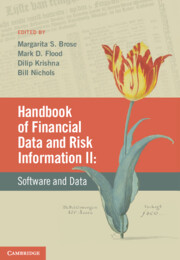Book contents
- Frontmatter
- Contents
- List of contributors
- Preface
- VOLUME II: SOFTWARE AND DATA
- PART IV DATA OPERATIONS IN FINANCIAL INSTITUTIONS
- 15 Financial market participants
- 16 Functional model for financial data and risk information
- 17 Financial institutions' data requirements
- 18 US residential-mortgage transfer systems: a data-management crisis
- PART V DATA MANAGEMENT TECHNOLOGIES
- PART VI IMPLEMENTATION OF DATA AND ANALYTICS PROGRAMS
- Index – Volume II
- References
18 - US residential-mortgage transfer systems: a data-management crisis
from PART IV - DATA OPERATIONS IN FINANCIAL INSTITUTIONS
- Frontmatter
- Contents
- List of contributors
- Preface
- VOLUME II: SOFTWARE AND DATA
- PART IV DATA OPERATIONS IN FINANCIAL INSTITUTIONS
- 15 Financial market participants
- 16 Functional model for financial data and risk information
- 17 Financial institutions' data requirements
- 18 US residential-mortgage transfer systems: a data-management crisis
- PART V DATA MANAGEMENT TECHNOLOGIES
- PART VI IMPLEMENTATION OF DATA AND ANALYTICS PROGRAMS
- Index – Volume II
- References
Summary
Introduction
The residential mortgage and mortgage-backed security (RMBS) markets in the USA are very large, and their operational practices have been deeply implicated in the continuing financial crisis. The systems in place to manage, monitor, store, and analyze the huge volumes of data associated with these markets have not kept pace with the rapid financial developments that have occurred in the last few decades, leaving the legal status of the market increasingly unclear, and leading to many data-related problems that have exacerbated the situation for millions of borrowers who either have lost or are about to lose their homes. Levitin (2010) discusses several examples, including questions regarding the following points.
• Numerous failures of financial institutions with a primary focus on residential lending.
• Widespread allegations of mispricing of mortgages and mortgage-backed securities.
• The validity of the mortgage chain of title in the securitization process, which could potentially cause MBS holders to be unable to go after collateral in the event of a default (see also Hunt et al., 2012).
• The effect of the use of the Mortgage Electronic Registration System (MERS) on the legal status of the mortgages underlying MBS (see also Hunt et al., 2012).
• Whether investors will be able to “put-back” to banks securitized mortgages on the basis of breaches of representations and warranties about the quality of the mortgages.
- Type
- Chapter
- Information
- Handbook of Financial Data and Risk Information IISoftware and Data, pp. 85 - 132Publisher: Cambridge University PressPrint publication year: 2014
References
- 1
- Cited by



